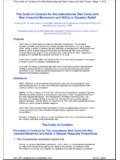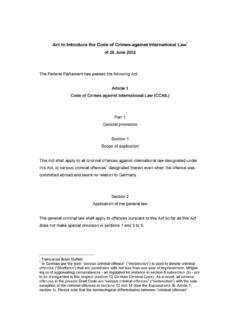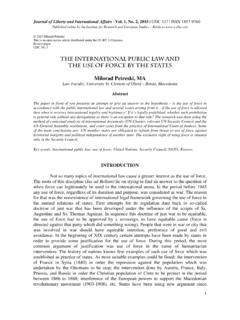Transcription of Humanitarian Law in Armed Conflicts - Manual
1 Humanitarian Law in Armed Conflicts - Manual - edited by The Federal Ministry of Defence of the Federal Republic of Germany VR II 3 August 1992 Preliminary Remarks 1. The present Manual of international Humanitarian law applicable in Armed Conflicts is the English version of the German triservice Manual ZDv 15/2 Humanit res V lkerrecht in bewaffneten Konflikten - Handbuch -, issued in August 1992. It shall serve soldiers and civilian personnel of all command levels in training courses, military exercises and in general training. 2. The design of this regulation largely dispenses with examples as far as they are not of any historical importance. Cases suitable for instruction and individual study are incorporated in ZDv 15/4 Humanit res V lkerrecht in bewaffneten Konflikten - Sammlung von F llen mit L sungen - [ Humanitarian Law in Armed Conflicts - Collection of Cases and Solutions].
2 3. The Annex to this Manual contains a survey of the distinctive emblems applicable under international law and a checklist for assessing the Situation with regard to international law, which is to provide an introduction into the handling of tasks associated with international law. The list of manuals and instruction aids dealing with international Humanitarian law which is also included in the annex shall facilitate access to these documents. The list of abbreviations may also be used as a survey of relevant international instruments. The detailed index is to permit quick orientation. 4. An abridged version of the present Manual is in preparation (ZDv 15/1 Humanit res V lkerrecht in bewaffneten Konflikten -Grunds tze - [ Humanitarian Law in Armed Conflicts - Principles -]).
3 5. The preparation of this Manual was a joint effort. This cooperation included active support by government experts from 18 States, representatives of the international Committee of the Red Cross and the international Institute of Humanitarian Law, San Remo, to whom the German Ministry of Defence expresses its particular gratitude. All participants in this exercise felt that a continuous dialogue on the implementation of international Humanitarian law is essential to ensure respect of applicable rules and that this dialogue should be broadened to embrace other cultures and Systems of law. While the German Ministry of Defence will continue to support this international cooperation, it bears full responsibility for this publication. Table of Contents Chapter 1 Historical Development and Legal Basis 101-149 I.
4 Definition of the Term " Humanitarian Law" 101-104 II. Historical Development 105-124 IIl. Legal Basis 125-129 IV. Humanitarian Requirements and Military Necessity 130-132 V. Binding Effect of international Law for the Soldier 133-145 VI. Tasks of the Legal Adviser 146-149 Chapter 2 Scope of Application of Humanitarian Law 201-249 I. Armed Conflicts 201-211 II. Acts of War 212-214 IIl. Area of War 215-220 IV. Termination of Hostilities 221-249 1. Parlementaires and Protecting Powers 222-231 2. Cease-fire and Armistice 232-240 3. Capitulations 241-244 4. Conclusion of Peace 245-249 Chapter 3 Combatants and Non-Combatants 301-330 I. Combatants 304-312 II. Non-Combatants 313-318 IIl. Persons Accompanying the Armed Forces 319 IV. Special Command Forces 320 V. Spies 321-324 VI. Peculiarities of Aerial and Naval Warfare 325-330 Chapter 4 Methods and Means of Combat 401-479 I.
5 General Rules 401-405 II. Means of Combat 406-440 1. Certain Conventional Weapons 406-426 2. NBC Weapons 427-440 a, Nuclear Weapons 427-433 b, Chemical Weapons 434-437 c, Bacteriological (Biological) and Toxin Weapons 438-440 III. Methods of Combat 441-479 1. Military Objectives 441-450 2. Protection of Civilian Objects 451-463 3. Protection of Works and Installations Containing Dangerous Forces 464-470 4. Ruses of War and Prohibition of Perfidy 471-473 5. Psychological Warfare 474-475 6. Reprisals 476-479 Chapter 5 Protection of the Civilian Population 501-598 I. General 501-518 II. Civil Defence 519-524 III. Belligerent Occupation 525-581 1. General Provisions 525-540 2. Legal Status of the Population 541-546 3. Rights and Duties of the Occupying Power 547-551 4. Requisition of Civilian Resources by the Occupying Power 552-566 5.
6 Supply Activities in Occupied Territories 567-571 6. Jurisdiction 572-581 IV. Aliens in the Territory of a Party to the Conflict 582-590 V. Internment of Civilians 591-598 Chapter 6 Protection of the Wounded, Sick and Shipwrecked 601-645 I. General 601-611 II. Medical Establishments and Transport 612-619 IIl. Medical Aircraft 620-623 IV. Medical Personnel 624-632 V. Hospital Zones and Localities 633-636 VI. The Distinctive Emblem 637-645 1. General 637-632 2. Camouflage of Medical Establishments 643-645 Chapter 7 Protection of Prisoners of War 701-733 I. General 701-704 II. Beginning of Captivity 705-713 III. Conditions of Captivity 714-726 IV. Escape of Prisoners of War 727-729 V. Termination of Captivity 730-733 Chapter 8 Religious Personnel 801-840 I. General 801-810 II. Protection of Chaplains 811-820 III.
7 Legal Status of Chaplains Retained by a Foreign Power 821-840 Chapter 9 Protection of Cultural Property 901-936 I. General 901-904 II. Specific Provisions for the Protection of Cultural Property 905-936 1. General Protection 905-909 2. Special Protection 910-918 3. Protection of Cultural Property during Occupation 919-922 4. Transport of Cultural Property 923-925 5. Personnel Engaged in the Protection of Cultural Property 926-928 6. Distinctive Marking of Cultural Property 929-936 Chapter 10 The Law of Armed Conflict at Sea 1001-1064 I. General 1001-1020 1. Definitions 1001-1009 2. Scope of Application 1010-1013 3. Acts of Naval Warfare, Competences, and Principles 1014-1020 II. Military Objectives and Protected Objects in Armed Conflict at Sea 1021-1038 1. Enemy Warships and Military Aircraft 1021 2. Enemy Merchant Ships, their Cargo, Passengers and Crew 1022-1033 3.
8 Protected Enemy Vessels (except hospital ships and ships under similar protection) 1034-1035 4. Protected Enemy Aircraft (except medical aircraft) 1036 5. Other Protected Objects 1037 6. Targets on Land 1038 III. Special Provisions Concerning Means and Methods of Naval Warfare 1039-1053 1. Mine Warfare 1039-1043 2. Torpedoes 1044 3. Missiles 1045 4. Submarine Warfare 1046-1047 5. Maritime Exclusion Zones 1048-1050 6. Blockade 1051-1053 IV. Hospital Ships. 1054-1064 1. General 1054 2. Conditions of Protection, Identification 1055-1056 3. Rights and Obligations 1057-1061 4. Discontinuance of Protection 1062 5. Personnel and Crew 1063-1064 Chapter 11 The Law of Neutrality 1101-1155 I. General 1101-1107 II. The Rights and Duties of Neutrals 1108-1155 1. General Provisions 1108-1114 2.
9 War on Land 1115-1117 3. Naval Warfare 1118-1148 a, General 1118-1125 b, Innocent Passage, Transit Passage and Arichipelagic sea lanes Passage 1126-1137 c, Control by Parties to the Conflict 1138-1146 d, Protection of Neutral Merchant Shipping 1147-1148 4. Aerial Warfare 1149-1155 Chapter 12 Enforcement of international Humanitarian Law 1201-1224 I. General. 1201-1202 II. Public Opinion 1203 III. Reciprocal Interests of the Parties to the Conflict 1204 IV. Maintenance of Discipline 1205 V. Reprisals 1206 VI. Penal and Disciplinary Measures 1207-1213 VII. Compensation 1214 VIII. Protecting Powers and their Substitutes 1215-1217 IX. international Fact-Finding 1218-1219 X. The international Committee of the Red Cross 1220 XI Diplomatie Activities 1221 XII.
10 National Implementing Measures 1222 XIII. Dissemination of Humanitarian Law 1223 XIV. Personal Responsibility of the lndividual 1224 Annex (nicht wiedergegeben) Appendix 1 Distinctive Emblems Appendix 2 Checklist for Assessing the Situation with Regard to international Law Appendix 3 Manuals and Instructional Aids Appendix 4 List of Abbreviations Index Chapter l Historical Development and Legal Basis I. Definition of the Term " Humanitarian Law" 101. The use of force is prohibited under Art. 2 (4) of the UN Charter. States may resort to force only in the exercise of their inherent right of individual or collective self-defence (Art. 51 UN Charter) or as part of military sanctions authorized by the Security Council (Articles 43-48 UN Charter).







